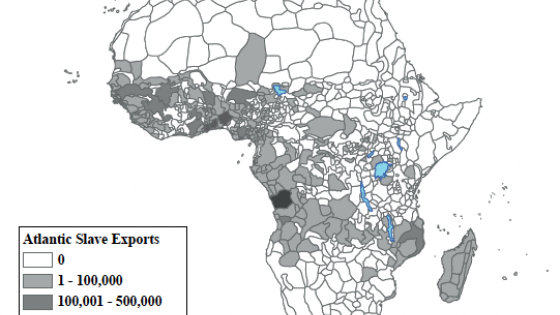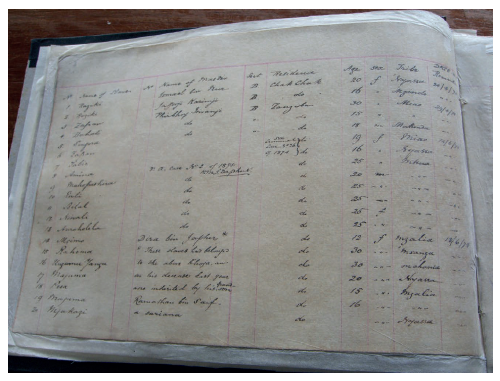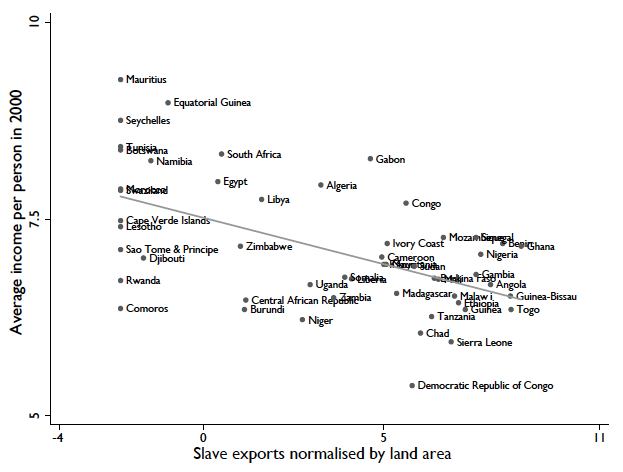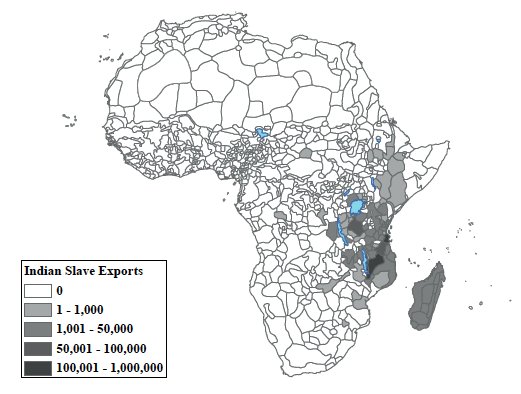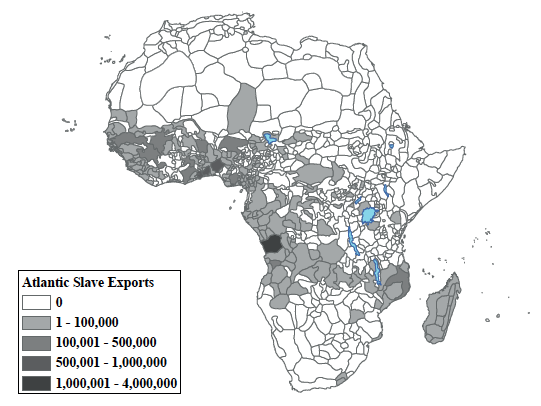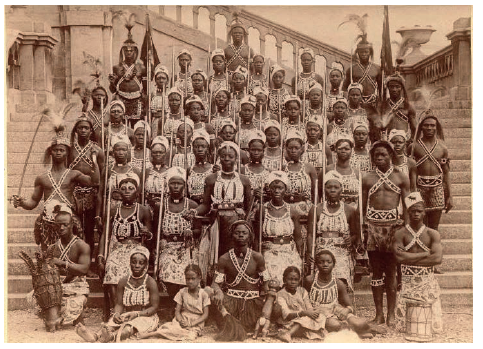Editor's note: This column first appeared as a chapter in the Vox eBook, The Long Economic and Political Shadow of History, Volume 2, available to download here.
Between 1400 and 1900, the African continent experienced four sizeable slave trades. The largest and best-known was the trans-Atlantic slave trade where, beginning in the 15th century, slaves were shipped from West Africa, West Central Africa, and Eastern Africa to the European colonies in the New World. The three other slave trades – the trans-Saharan, Red Sea, and Indian Ocean slave trades – were smaller in scale and predated the trans-Atlantic slave trade. During the trans-Saharan slave trade, slaves were taken from south of the Saharan desert and shipped to Northern Africa. In the Red Sea slave trade, slaves were taken from inland of the Red Sea and shipped to the Middle East and India. In the Indian Ocean slave trade, slaves were taken from Eastern Africa and shipped either to the Middle East, India, or the plantation islands in the Indian Ocean. In total, close to 20 million slaves were taken from the continent (Nunn 2008). According to the best estimates, by 1800 Africa’s population was half of what it would have been, had the slave trades not occurred (Manning 1990).
Slaves were captured through kidnappings, raids, and warfare. A summary of the method of enslavement among a sample of 144 former slaves is provided in Table 1. Historical accounts suggest that the pervasive insecurity, violence and warfare had detrimental impacts on the institutional, social, and economic development of societies. There are numerous examples of the slave trades causing the deterioration of domestic legal institutions, the weakening of states, and political and social fragmentation (e.g. Inikori 2000, 2003, Heywood 2009).
Table 1. The methods of enslavement of Koelle’s Informants
Notes: The data are from Sigismund Koelle’s Linguistic Inventory. The sample consists of 144 informants, interviewed by Koelle, for which their means of enslavement is known.
The most illustrative example of this is the experience of the Kongo Kingdom, which was contacted in 1493 by Diogo Cao. Initially, a diverse array of products was traded between the Kongo Kingdom and the Portuguese, including copper, textiles, ivory, and slaves. At first, the only slaves to be traded were prisoners of war and criminals. However, the Portuguese demand for slaves, the pervasiveness of slave traders and merchants, and competition for the throne within the Kingdom all resulted in a dramatic and uncontrollable increase in slave capture and raiding throughout the Kingdom. By 1514, King Afonso (the Kongo King) had already written to the King of Portugal, complaining that the Portuguese merchants were colluding with noblemen to illegally enslave Kongolese citizens. In 1526, in an effort to end the trade, King Afonso requested the removal of all Portuguese merchants. In the end, his efforts were unsuccessful. Large scale slave-raiding continued unchecked into the 16th century, when it culminated in the Jaga invasion of 1568-1570. Large-scale civil war ensued from 1665-1709, resulting in the collapse of the once-powerful Kingdom (Heywood 2009).
An empirical literature has emerged that aims to supplement these historical accounts with quantitative estimates of the long-run impact of Africa’s slave trades. The first paper that attempted to provide such estimates was Nunn (2008). In the study, I undertook an empirical test, with the following logic. If the slave trades are partly responsible for Africa’s current underdevelopment, then, looking across different parts of Africa, one should observe that the areas that are the poorest today should also be the areas from which the largest number of slaves were taken in the past.
To undertake this study, I had to first construct estimates of the number of slaves taken from each country in Africa during the slave trades (i.e. between 1400 and 1900).
These estimates were constructed by combining data on the number of slaves shipped from each African port or region with data from historical documents that reported the ethnicity of over 106,000 slaves taken from Africa. Figure 1 provides an image showing a typical page from these historical documents. The documents shown are slave manumission records from Zanzibar. Each row reports information for one slave, including his/her name, ethnicity, age, and so on.
After constructing the estimates and connecting these with measures of modern day economic development, I found that, indeed, the countries from which the most slaves had been taken (taking into account differences in country size) were today the poorest in Africa. This can be seen in Figure 2, which is taken from Nunn (2008). It shows the relationship between the number of slaves taken between 1400 and 1900 and average real per capita GDP measured in 2000. As the figure clearly shows, the relationship is extremely strong. Furthermore, the relationship remains robust when many other key determinants of economic development are taken into account.
Figure 1 Excerpt from document taken from Zanzibar archives
Figure 2 The relationship between slave exports (normalised by a country’s land area) and real per capita GDP in 2000. Both variables are measured on a log scale
An alternative interpretation of the relationship shown in Figure 2 is that the parts of Africa from which the largest number of slaves were taken were initially the most underdeveloped. Today, because those characteristics persist, these parts of Africa continue to be underdeveloped and poor.
I also tested this alternative hypothesis by checking whether it was, in fact, the initially least developed parts of Africa that engaged most heavily in the slave trades. I find that the data suggest that, if anything, it was the parts of Africa that were initially the most developed, not least developed, that supplied the largest number of slaves. In the analysis, I also used a statistical technique called instrumental variables estimation to identify the causal effect of the slave trade on economic development. The findings from the instrumental variables estimates suggested that increased extraction during the slave trades did, indeed, cause worse economic performance. Overall, the conclusion from the analyses is that the relationship shown in Figure 2 is most likely causal and not spurious.
My estimates in Nunn (2008) allowed, for the first time, the impacts the slave trades had on economic development to be understood quantitatively. In particular, using the estimates, one is able to calculate how much more developed Africa would be, if the slave trades had not taken place. These calculations were undertaken in Nunn (2010). As an initial step in the calculation, first note that the mean level of average per capita income of the countries in Africa is $1,834 (measured in 2000). This is significantly lower than the income for the rest of the world (which is $8,809), and it is much lower even than the income of other developing countries (which is $4,868), where a developing country is defined as one with less than $14,000 in per capita income. According to the estimates from Nunn (2008), if the slave trades had not occurred, then 72% of the average income gap between Africa and the rest of the world would not exist today, and 99% of the income gap between Africa and other developing countries would not exist. In other words, had the slave trades not occurred, Africa would not be the most underdeveloped region of the world and it would have a similar level of development to Latin America or Asia.
My findings in Nunn (2008) provided suggestive evidence that much of Africa’s poor performance can be explained by its history, which is characterised by over 400 years of slave raiding. Although my analysis stopped short of providing a definitive understanding of exactly how and why the slave trades were so detrimental to economic development, it did provide suggestive evidence that was consistent with historical accounts of the slave trades resulting in a weakening and underdevelopment of political structures, as well as in impeding the formation of broader ethnic groups, leading to more ethnic diversity. The study showed that the countries from which the largest numbers of slaves were taken were also the areas that had the most underdeveloped political structures at the end of the 19th century, as well as being the countries that are the most ethnically fragmented today.
A number of studies followed on from the research in Nunn (2008), by attempting to better understand the channels through which the slave trades affect economic development today. Green (2013) revisited the impact of the slave trade on ethnic fractionalisation. He extended the findings in Nunn (2008) by examining the entire world, and constructing estimates of the export of slaves in all countries in the world. Using these data, he also found a strong relationship between slave exports and greater ethnic fractionalisation.
According to his estimates, all of the difference in ethnic fractionalisation between Africa and the rest of the world can be explained by its experience with the slave trades.
In a series of studies, Whatley and Gillezeau (2011) and Whatley (2014) combine slave shipping records with ethnographic data and estimate the relationship between slave shipments and institutional quality and ethnic diversity in the locations close to the ports of shipment. Their analysis, consistent with Nunn (2008) and Green (2013), indicates that the slave trades did result in greater ethnic fractionalisation. In addition, their analysis also shows that the slave trades resulted in a deterioration of local ethnic institutions, measured in the late pre-colonial period.
Another subsequent study, undertaken by Nunn and Wantchekon (2011) asks whether the slave trades resulted in a deterioration of trust. The paper’s line of enquiry was motivated by two facts. The first is that trust has been long-hypothesised to be an important foundation for economic prosperity (e.g. Algan and Cahuc 2010). The second was the fact that, during the slave trades, individuals frequently turned on one another, kidnapping, tricking, and selling each other into slavery. The existing historical evidence indicates that these forms of betrayal were common. For example, among the sample of slaves reported in Table 1, 20% became slaves because they were tricked by a family member or friend.
In our study, Wantchekon and I extended the data construction efforts in Nunn (2008) and constructed estimates of the number of slaves taken from each ethnic group in Africa (rather than country). The ethnicity level estimates are displayed visually in Figure 3. The analysis combined the ethnicity-level slave export estimates with fine-grained household survey data, which reports individuals’ trust of those around them, whether neighbours, relatives, local governments, co-ethnics, or those from other ethnicities. The study documented a strong negative relationship between the intensity of the slave trade among one’s ethnic ancestors and an individual’s trust in others today.
The study then attempted to distinguish between the two most likely channels through which the slave trades could have adversely affected trust. One is that the slave trades made individuals and their descendants inherently less trusting. That is, it created a culture of distrust. In the insecure environment of the slave trade, where it was common to experience the betrayal of others, even friends and family, greater distrust may have developed, which could persist over generations even after the end of the slave trade.
Another possibility is that the slave trades may have resulted in a long-term deterioration of legal and political institutions, which are then less able to enforce good behaviour among citizens, and as a result people trust each other less today.
The study undertook a number of different statistical tests to identify the presence and strength of the two channels. They found that each of the tests generated the same answer: both channels are present. The slave trades negatively affected domestic institutions and governance, which results in less trust today. In addition, the slave trade also directly reduced the extent to which individuals were inherently trusting of others. We also found that, quantitatively, the second channel is twice as large as the first channel.
The ethnicity-level slave export estimates I constructed with Wantchekon spurred a second line of research that looked into other impacts of the slave trade, using the new finer-grained data. For example, Zhang and Kibriya matched the ethnicity-level slave export data from Nunn and Wantchekon (2008) with fine-grained data on the location and intensity of conflicts within Africa from 1997-2014. They find a strong positive relationship between the intensity of the slave trades and the prevalence of civil conflict today. Given the strong link between income and conflict, this likely represents an important channel behind the reduced-form relationship between the slave trades and income documented in Nunn (2008).
A number of subsequent studies have also explored other cultural consequences of the slave trades. For example, research by Edlund and Ku (2011), Dalton and Leung (2014), and Bertocchi and Dimico (2015) found that the trans-Atlantic slave trade resulted in a long-term increase in the prevalence of polygyny (i.e. the practice of men having multiple wives). This is due to the fact that it was primarily males who were captured and shipped to the Americas, resulting in a shortage of men and skewed sex ratios within many parts of Africa. Interestingly, Dalton and Leung (2014) found that there is no evidence of such an impact for the Indian Ocean slave trade, where there was not a strong preference for male slaves. This has led the authors to conclude that Africa’s history of the slave trades is the primary explanation for why today polygyny is much more prevalent in West Africa than in East Africa.
Figure 3 Maps showing the number of slaves taken from each ethnic group in Africa during the trans-Atlantic and Indian Ocean slave trades
a) Indian slave exports
b) Atlantic slave exports
The study by Bertocchi and Dimico (2015) is particularly interesting, because it takes the analysis one step further and shows that the greater prevalence of polygyny, which arose due to the slave trade, has led to an increase in HIV rates. They document that women who are in a polygynous relationship are more likely to have sexual partners other than their husband. This is perhaps not surprising, since in polygamous societies wealthy older men are typically the ones who have multiple wives, leaving a large number of young able-bodied men, without wives, able and willing to engage in extramarital relationships. Thus, according to the authors’ findings, the trans-Atlantic slave trade is an important factor in explaining the high rates of HIV in Africa today.
A study by Teso (2016) also examined the consequences of the skewed sex ratio that resulted during the trans-Atlantic slave trade, but focused on the impacts on female labour force participation. The shortage of males in the population, during the trans- Atlantic slave trade, meant that women had to undertake many of the tasks traditionally performed by men, such as those in agriculture, or in the military, and to accept positions of leadership and authority. The Dahomean female ‘Amazon’ army, shown in Figure 2, is the best-known example of this. The female army was established by Dahomey in the 17th century at the height of the slave trade, and their existence continued until the end of the 19th century. Teso’s (2016) research shows that those parts of Africa that experienced the trans-Atlantic slave trade most severely have higher rates of female labour force participation today.
Figure 4 A photo of the female army of Dahomey, who were often referred to as ‘Amazons’
A number of studies have turned the line of research started in Nunn (2008) on its head by asking, not ‘What were the consequences of the slave trades?’, but ‘What were the causes of the slave trades?’. Fenske and Kala (2015) examined what role weather played by combining information on slave shipments with data on annual historical temperatures, measured at a 5-degree grid-cell level. They found that negative weather shocks (taking the form of abnormally cold years) increased the supply of slaves from the locations that experienced these shocks. They also find that locations that experienced such shocks during the height of the slave trade tend to have lower income levels today. In a separate study, the same authors examined how the suppression of the slave trade after 1807 affected slave shipments (Fenske and Kala 2016). Not surprisingly, the suppression led to a decline in slave exports, although this was focused in British-controlled parts of the continent. The authors also showed that the decline in slave exports occurred alongside an increase in violence and coercion within the continent. Thus, the evidence suggests that not only did the slave trade have detrimental effects, but possibly its abolition did too.
A study by Nunn and Puga (2015) has examined the extent to which geography affected the capture and export of slaves during the slave trades. My co-author and I used the data from Nunn (2008) to document how uneven terrain, taking the form of cliffs, ridges, and escarpments, was used by societies to defend against and escape from slave raiders. The uneven terrain could be used to help build defensive fortifications and to provide places to escape, in the face of slave raids. We show that, as a consequence, those places in Africa that are more rugged were better able to escape the slave trade and, thus, are richer today.
Although research understanding the long-term impacts of Africa’s slave trades is still in progress, the evidence accumulated up to this point suggests that this historic event played an important part in the shaping of the continent, in terms of not only economic outcomes, but cultural and social outcomes as well. The evidence suggests that it has affected a wide range of important outcomes, including economic prosperity, ethnic diversity, institutional quality, the prevalence of conflict, the prevalence of HIV, trust levels, female labour force participation rates, and the practice of polygyny. Thus, the slave trades appear to have played an important role in shaping the fabric of African society today.
References
Algan, Y and P Cahuc (2010), “Inherited Trust and Growth,” American Economic Review 100 : 2060-2092.
Bertocchi, G and A Dimico (2015), The Long-Term Determinants of Female HIV Infection in Africa: The Slave Trade, Polygyny, and Sexual Behavior, IZA DP No. 9102
Dalton, J T and T C Leung (2014), “Why is Polygyny More Prevalent in Western Africa? An African Slave Trade Perspective”, Economic Development and Cultural Change, 63 599-632.
Edlund, L and H Ku (2011), The African Slave Trade and the Curious Case of General Polygyny, MPRA Paper NO. 52735
Fenske, J and N Kala (2015), “Climate and the Slave Trade”, Journal of Development Economics, 112: 19-32.
Fenske, J and N Kala (2016), 1807: Economic Shocks, Conflict and the Slave Trade, Working paper.
Green, E (2013), “Explaining African Ethnic Diversity”, International Political Science Review, 34: 235-253.
Heywood, L (2009), “Slavery and its Transformation in the Kingdom of Kongo: 1491–1800”, Journal of African History, 50: 1-22.
Inikori, J E (2000), “Africa and the Trans-Atlantic Slave Trade,” in Africa Volume I: African History before 1885, Toyin Falola, (ed.), Durham, NC: Carolina Academic Press.
Inikori, J E (2003), “The Struggle against the Trans-Atlantic Slave Trade,” in Fighting the Slave Trade: West African Strategies, A. Diouf, (ed.), Athens, OH: Ohio University Press.
Manning, P (1990), Slavery and African Life, Cambridge, UK: Cambridge University Press.
Nunn, N (2008), “The Long-Term Effects of Africa’s Slave Trades”, Quarterly Journal of Economics, 123: 139-176.
Nunn, N 2010), “Shackled to the Past: The Causes and Consequences of Africa’s Slave Trades”, in J Diamond and J A Robinson (eds.), Natural Experiments of History, pp. 142-184. Harvard University Press.
Nunn, N and D Puga (2012), “Ruggedness: The Blessing of Bad Geography in Africa”, Review of Economics and Statistics, 94: 20-36.
Nunn, N and L Wantchekon (2011), “The Slave Trade and the Origins of Mistrust in Africa”, American Economic Review, 101: 3221-3252.
Teso, E (2016), The Long-Term Effect of Demographic Shocks on the Evolution of Gender Roles: Evidence from the Transatlantic Slave Trade, Working Paper, Harvard University.
Whatley, W and R Gillezeau (2011), “The Impact of the Transatlantic Slave Trade on Ethnic Stratification in Africa”, American Economic Review Papers and Proceedings, 101: 571-576.
Whatley, W C (2014), “The Trans-Atlantic Slave Trade and the Origins of Political Authority in West Africa”, In E Akyeampong, R H Bates, N Nunn, J A Robinson (eds) Africa’s Development in Historical Perspective, pp. 460-488. New York: Cambridge University Press.
Zhang, Y and S Kibriya (2016), The Impact of the Slave Trade on Current Civil Conflict in Sub-Saharan Africa, Working paper, Texas A&M University.
